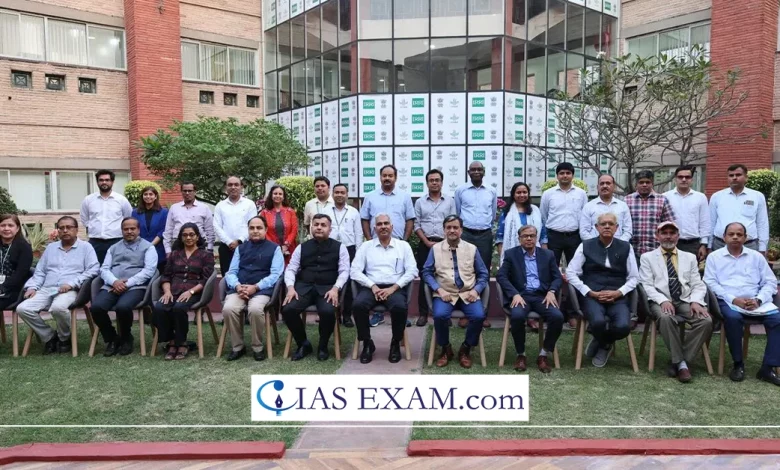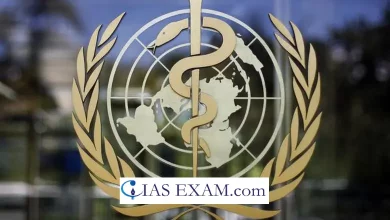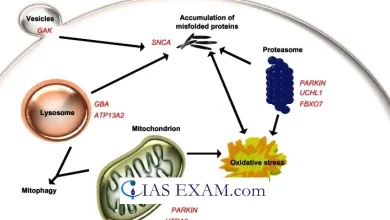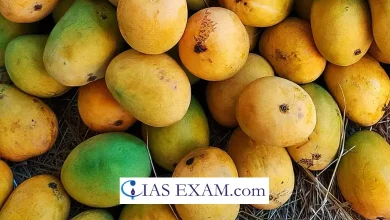IRRI-ISARC Aims For Low-Methane Emission Rice Varieties
Syllabus: Science and Technology [GS Paper-3]

Context
The International Rice Research Institute (IRRI) and its South Asia Regional Centre (ISARC) are focusing on the development of rice varieties that produce low levels of methane emissions. This initiative is part of a broader effort to create a more sustainable and climate-resilient agri-food system in the South Asia region.
Details on the development of low methane emission rice varieties by IRRI-ISARC
- Objective: The prevalent purpose is to use rice varieties that produce low methane discharge, in addition to possessing phenotypic traits such as the capacity to withstand climatic stress, accelerated crop maturing, biofortification, and nutrition.
- Agronomic Practices: To help the adoption of low-methane rice types, ISARC is assisting in better agronomic and management practices also. Such techniques include the Dry Seeded Rice (DSR) and the Alternate Wetting and Drying (AWD) which are among the top ways of minimising the levels of global greenhouse gas emissions in the environment.
- DSR Technique: Dry Seeded Rice is prominently already an ongoing research program under IRRI. Through FRB, it happens quicker. It consumes less water and labour crafting at the same time, mechanisation and emissions greenhouse gas are moreover brought down.
- Coordination and Collaboration: Developed along with agriculture departments of related countries like India, Bangladesh, Sri Lanka and Nepal, the program is an integral part of the plan. The 7th ISARC Coordination Committee meeting, which happened in Varanasi, worked as a forum for these stakeholders to share the results of the previous activities and to set a framework of how future activities will be organised.
Advantages of Low-methane emission rice varieties
- Low-methane emission rice varieties produce less methane during cultivation, which helps mitigate climate change and global warming.
- They contribute to climate change mitigation efforts, aligning with international agreements like the Paris Agreement.
- The methane molecule may be the intermediate stage of ozone formation which is the major cause for ground-level air pollution. Through the cut of methane emission, these rice varieties can help to have better air quality and the reduction of the formation of ground-level ozone.
- Implementation of rice cultivar varieties with low-methane emission can help to sustain the agricultural operations and save natural resources and environments
- Over a long term period, the economic benefits of reduced input costs, added value through sustainability and getting into carbon credit markets may accrue. Such expenditures for researchers is a necessity at the start, but widespread adoption may be a driver of economic benefits in the long run.
Disadvantages of Low-methane emission rice varieties
- Low-methane emission rice varieties face several concerns, including potential yield reduction, genetic modification concerns, limited agronomic options, substantial research and development costs, and adoption challenges.
- Farmers might need to be convinced about these varieties as they may feel that the yields could be lowered upon their adoption. Genetically modified rice strains also involve such issues as regulatory approvals, consumer acceptance and environmental effects since they are novel and may have potential risks.
- Lack of different agronomic practices handicaps farmers and slows the pace of farmer decision and field trial adoption. Research and development costs can present difficulties for developing countries that do not have sufficient farming research ability.
- The challenges of adoption of these technologies may include lack of awareness, limited access to seeds, and agronomic performance concerns.
International Rice Research Institute (IRRI)
- The International Rice Research Institute (IRRI), founded in 1960, is a global nonprofit organisation focused on improving the lives of rice farmers and consumers worldwide.
- Research covers breeding, genetics, agronomy, pest management, and socioeconomics.
- Focuses on developing high-yielding, stress-tolerant rice varieties.
- Partners with stakeholders to address complex challenges in rice agriculture.
- Participates in global research networks for sustainable rice production practices.
- Disseminates research findings, technologies, and best practices for broad adoption.
International South Asia Regional Centre (ISARC)
- The International South Asia Regional Centre (ISARC) is a research and development centre in South Asia aimed at improving rice production and seed quality in sub-Saharan Africa and South Asia.
- It houses advanced laboratory facilities and the Centre for Excellence in Rice Value Addition (CERVA), which focuses on achieving premium grain quality and improved nutrition in rice.
- ISARC promotes collaboration and provides training to various institutions, scientists, and stakeholders. Its vision is to deliver research services to both private and public sectors.
Source: Hindustan Times
Read More: Sustainability of Agri-Exports in India
UPSC Mains Practice Questions
Q.Discuss the significance of the collaboration between the International Rice Research Institute (IRRI) and the South Asia Regional Centre (ISARC) in developing low-methane emission rice varieties. Examine the potential environmental and agricultural impacts of such research initiatives and suggest measures to enhance their effectiveness in promoting sustainable rice cultivation practices.





.png)



